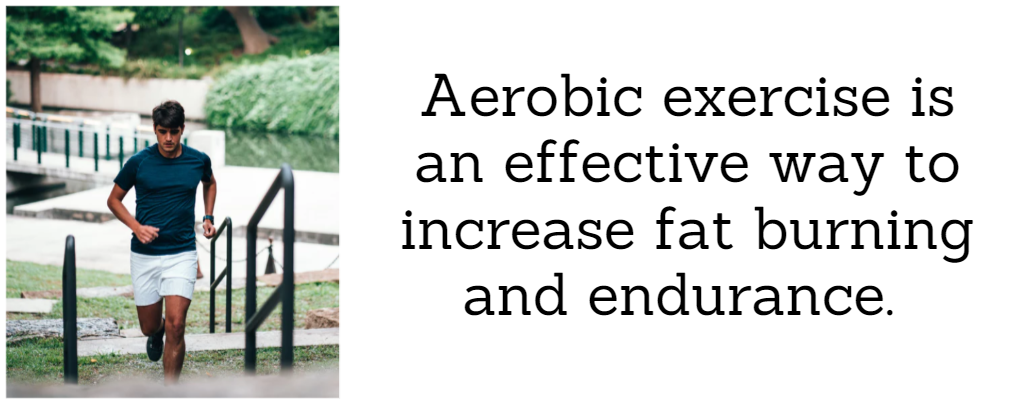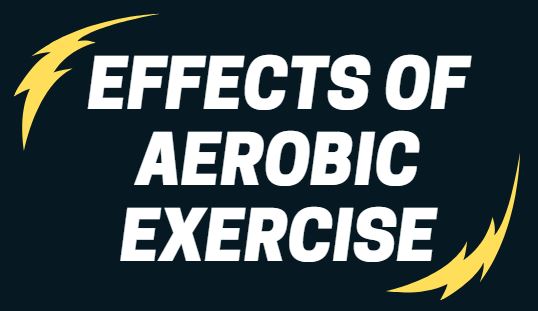Aerobic exercise is an effective way to increase fat burning and endurance. The power not only comes from just one work-out and how it makes you feel, but the cumulative effects regarding all the physiological benefits are quite staggering.
Contents
- 1 Effects of Aerobic Exercise
- 2 The Role of Mitochondria In Producing Energy From Nutrients
- 3 Warming-up for Aerobic Exercise
- 4 Aerobic Exercise Examples: Time and Duration
Effects of Aerobic Exercise
It is the form of exercise that is most effective for lowering blood pressure, decreasing body fat, controlling blood sugar, increasing stamina 🙂 , and many others.
How does it do this? How is a fit person able to burn more energy and perform more work? How is a fit person able to eat more than an overweight person, yet athletes are noted as being grouped among the leanest in the population?
To answer this, we need a very basic and brief overview of education regarding exercise physiology.
A fit person’s heart is able to deliver more oxygen to their working muscles, and a fit person’s muscle can use this added oxygen or O2 more efficiently and to a much higher degree than an unfit person.
This is a fit person can do more work.
They can get more O2 to their muscles by developing more blood cells and more blood vessels than an unfit person. Having more O2 on demand is not enough. Your muscles still need to be able to process this at a higher rate than a non-fit person.
It’s kind of like a construction company. It is one thing to have more equipment transported to the project site; it is yet another thing to acquire more employees to speed up the usage of the equipment.
Mitochondria Turn Fuel Into Energy
Our body needs to do these similar tasks as well; but with processing food into energy. A fit person has more capability to burn fuel than an unfit person. A fit person has more and bigger mitochondria inside their muscles to turn this fuel into energy. This works even better with intermittent fasting.
The Role of Mitochondria In Producing Energy From Nutrients
Squatting position, Calf (leg), Aerobic exercise, Exercise, Squat (exercise), Foot, Weight loss, Push-up, Physical fitness, Physical exercise. Recreation, Human anatomy, Human body, Skipping rope, Human activities, Sports, Self-care, Knee, Musculoskeletal system. Gluteus maximus, Hamstring, Limbs (anatomy), Primate anatomy, Fat, Lower limb anatomy, Human back. Quadriceps femoris muscle, Jogging, Core stability, Hip, Abdomen, Hand, Muscle, Flutter kick, Physiology, Shoulder. Jumping jack, Thigh, Athletic sports, Body shape, Flexibility (anatomy), Heart, Human weight, Circulatory system, Arm. Energy, Individual sports, Nutrition, Waist, Elbow, Depression (mood).
Enzymes
The muscle also has more enzymes that are responsible for taking fat out of the bloodstream, breaking it down, and converting it to energy. Conversely, an unfit person has more enzymes that are responsible for taking fat from the muscle cell and putting it back into the bloodstream where it can be stored in a fat cell as adipose tissue.
All this adds up to our muscles being able to use more oxygen to do more work. It should be noted that in order for these and other changes in your physiology to take place, you need to put your body through a certain amount of exercise.
Your body reacts to aerobic exercise by becoming more efficient. The amount and type of exercise will be discussed below. Here is a great fact. Muscles account for about 80 to 85% of all of our metabolic demands!
It should now be apparent how important regular aerobic exercise is to all of us to prevent and/or control lifestyle-triggered diseases.
Warming-up for Aerobic Exercise
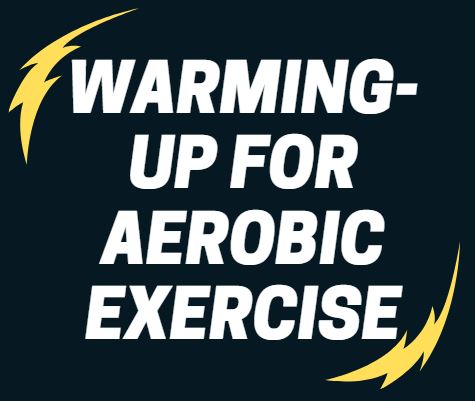
Warm-up: In order to perform aerobic exercise safely, everyone should always warm-up before every aerobic or weight training session. A proper warm-up will help your heart get ready for your exercise session. Your heart needs more oxygen itself when it works harder. It is, after all, a muscle too. It will also enable you to have an easier work-out so that you can perform better.
Heart Rate and Workout Intensity
Typically, resting heart rates are about 60 to 80 bpm. All exercise sessions should gradually increase the heart rate from resting levels to the prescribed range, usually within 5 to 10 minutes.
It ought to be a gentle boost in your workout intensity or tempo so that after your warm-up period you will be at the recommended work-out intensity.
A longer duration activity to warm up may be desired if you are at a high health risk, are unusually stiff or sore, are exercising in cold weather, or are getting used to a new movement.
If possible, warm-up exercises should involve movements or sport specific tasks that you plan to perform during your workout session.
Four Factors When Starting An Aerobic Exercise Program
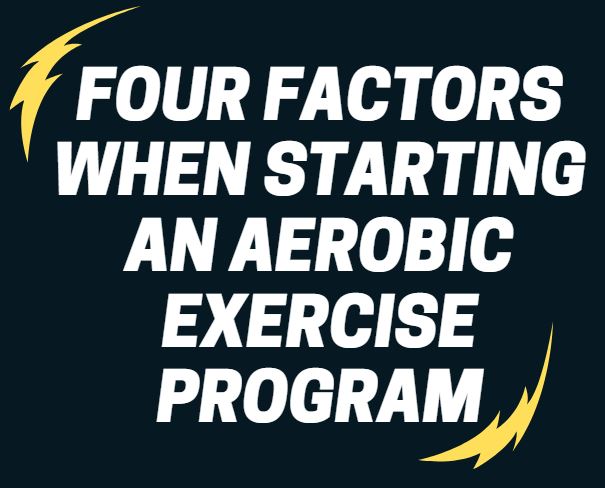
Frequency; Intensity; Time; and Type (FITT).
Frequency of Aerobic Exercise
This refers to how often you formally exercise. The frequency of exercise is perhaps the most important for developing a fitness habit. Daily exercise is perhaps the best way of making it a habit. Write it in your daily schedule.
TIP: Watch your favorite half hour or hour TV program only when you are exercising. Going downstairs to the laundry room to exercise on your treadmill is not a very good environment. Try to exercise in comfortable surroundings.
Fitness Effects of Aerobic Exercise
Since the cumulative benefits of exercise are only apparent in time with small incremental changes in your physiology, patience is the key. It takes 3,500 calories to burn a pound of fat. You may only be able to burn 200 at first if you are out of shape, progressing up to losing 10 pounds in a month.
However, if you do simple things like taking the stairs instead of the elevator, getting up and walking to the fountain regularly at work to drink water, it will add up. This cannot be overstated.
Lowering Body Fat
Accumulating all the “little” things throughout each year can have a substantial role in lowering body fat to get six pack abs. Start out gradually. If you are not accustomed to exercising at all or are in poor health (check with your doctor for guidelines), three times a week to start is a great beginning.
Over the next month, you can increase this to 4 to 5 times per week. Finally, after 4 to 6 weeks, you should be able to exercise 5 to 7 days per week comfortably.
Walking
Note: If you are to the point where you are exercising fairly hard, taking a day off each week may be beneficial. If you are very unconditioned or are in poor health and can only walk for a few minutes, then you may need to exercise multiple times per day, such as 3 minutes of walking or riding a stationary bike 5 or 6 times throughout the day.
That’s 15 to 18 minutes total! The minimum amount of aerobic exercise in order for physiological adaptations to take place is three days per week, according to the American College of Sports Medicine (ACSM).
Activity Intensity- How Hard You Exercise
This refers to how hard you exercise. You can also classify the exercise or movement itself. Some exercises are just harder than others. It requires more effort to play basketball than it does to bowl, for instance.
There are lots of ways to keep track of your body when you workout to see how hard you are performing.
Sometimes, intensity monitoring is more important than at other times. Many people (even some great athletes) don’t monitor themselves much at all. They may go by how their body feels.
However, in some cases, it is very important, such as if you have had a heart attack and your doctor told you that you have an upper limit on how hard you should or can work.
For most people, some form of intensity monitoring can provide valuable feedback on your progression and maximize your success.
Note: Running a mile burns the same amount of calories as walking a mile. It is the same amount of overall work! We will start off these monitoring techniques with an easy one, breathing.
Breathing or Respiratory Rate During Aerobic Exercise
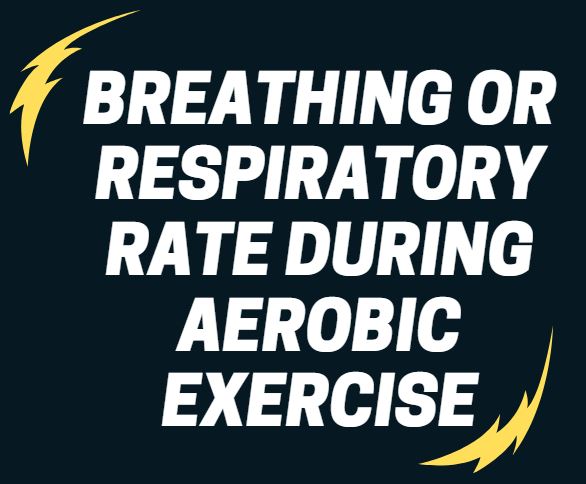
Breathing or Respiratory rate. This is how much and how hard exercise makes you breathe. So you simply count your breathing rate. You do this by talking! See, the only way to actually count your own breathing rate is to see how many words you can say without taking a breath.
Pace
Nobody is able to get an accurate count of their own breathing rate if they are thinking about it. This is why we indirectly count it by your ability to talk. You may have heard of the talk test. That is, you should be able to complete a fairly short sentence (out loud) without having to inhale to take another breath.
If you cannot complete a short sentence or you have to pause frequently when speaking, then perhaps you’re exercising too hard, and you should reduce your pace. On the other hand, if you can string long sentences together and “go on and on” then perhaps you are not exercising hard enough.
Heart Rate
Our heart rate (HR) increases as we exercise harder. It does so in order to effectively supply more O2 to our working muscles. Most of us have heard about monitoring our heart rate when we exercise.
There are three different ways to do this. An actual measured maximum heart rate can be determined by an exercise test. The heart rate reading at the peak VO2 (volume of oxygen consumption) attained during the exercise test will be your actual measured maximum heart rate.
Your recommended training intensity can be determined using a certain percentage of this number. Your doctor or exercise physiologist can determine what percentage would be the best range for you.
We can also predict how high your heart rate can get up to with reasonable accuracy with two different heart rate formulas. One widely used method used to get our HR range is to do some simple math to predict how many times our heart is able to beat in one minute.
The formula is 220 – age. We then use a certain percentage of this number to come up with a target HR range for you to exercise at. We use a percentage of this number for a simple reason. The HR you get with 220 – age means the maximum that your heart has the capacity to beat in a minute or simply its greatest rate possible.
All of us do not and should not exercise at our maximum for any length of time. Most of us would only be able to exercise at our true maximum rate or intensity for about 10 to 30 seconds.
Percentages of your HR number usually range from 70 to 85 %. You seek out the lower end if you are not in good shape or are at high risk for disease. The higher end is usually reserved for more fit individuals who are apparently healthy.
You may go lower or higher than this range if you need to. Here is an example:
A 45-year-old female with no health concerns wants to start an exercise program. Her maximum heart rate would be predicted at 220 – 45 = 175 bpm. Her HR range is 70 to 85%. 175 x .70 = 123 bpm. 175 x .85 = 149 bpm. Her target heart rate range is 123 – 149 bpm.
She should start on the low end of this range as she is just starting an exercise program. This is where her HR should be at near the end of her warm-up and continue for the recommended period of time.
She can check this while exercising by counting her pulse for 10 seconds and multiplying by 6 to get beats per minute (bpm). If you have to stop to do this, you should obtain your pulse within 5 seconds after you stop exercising. Our HR drops significantly after about 15 seconds of stopping exercise.
The other HR prediction formula may be more accurate than the 220 – age method because it takes into consideration our resting HR. This formula is expressed as the heart rate reserve (HRR) or the Karvonen formula.
Karvonen Formula for Target Heart Rate
Our resting HR decreases as we become more fit. This is one of the benefits of aerobic exercise. Our heart is able to pump more blood out of each beat so it can slow down and still get the amount of blood or oxygen (O2) we need to the rest of our body.
Since our resting HR changes as our fitness level changes, we should re-check this number maybe once a month. First, we need to get our resting HR number. This should be done in the morning while you are in bed before the kids start ordering you around and get your HR up.
It should also be an average of 3 days. Count your carotid (neck) or brachial (wrist) artery pulse or heartbeat. Count how many beats in one full minute. This is your once a month job.
Here is the formula once you got your resting heart rate. (220 – age) – (resting HR) x .60 + (resting HR).
So let’s take our lady above. She is 45 years old. Her resting HR average is 64 bpm. We will use 60 to 80% of her HRR for a training HR. (220 – 45) – 64 x .60 + 64 = 131 bpm. This is her HR at 60% of her maximum. We now need an upper limit.
Again, we will use the same formula as in the previous example, with the difference of using 80% instead of 60%. So we take (220 – 45) – 64 x .80 + 64 = 153 bpm. Her HR range with this formula is 131 to 153 bpm.
Again, since this lady is just starting an exercise program, she should stay at the lower end of this range for a while until she gets in better shape.
Rate of Perceived Exertion (RPE)
This is a rating of how hard you feel you’re exercising, regardless of what your heart rate is. This is perhaps the easiest way to monitor your aerobic intensity. The rating scale was invented by a psychologist named Borg about 70 years ago. It is very accurate way to monitor your exercise intensity.
He made two scales. The initial one begins with 6 (as in 60 bpm for resting HR) and goes up to 19 (as in 190 bpm for a maximum HR). The later scale goes from 0 through 10. Please see the RPE chart. This is the one I like to use.
There are gaps in the scale where rating adjectives fall that correspond to a number. The reason for the gaps is to correlate that our perception of exertion goes up at a faster and faster pace as we exercise harder. This is called an exponential curve.
Treadmill Test
For example, when someone walks at three mph on a level surface, they rate their intensity as a 2 (0 – 10 scale). The treadmill increases to 3.5 mph, and the person still rates their RPE at a 2. The treadmill (TM) is now up to 3.5 mph at 4% incline. RPE is at 3. TM is now up to 4 mph, and 5% incline and this person rates intensity at 4.
Now the TM is at 4.5 mph and at a 8% incline. The person rates the intensity at 6. The TM is now at 5.2 mph, and 10% incline and the person rates the work as a 7. This number corresponds to “very hard.” The person’s heart rate should indicate this as well, being at the upper end or even over the HR range for this person.
RPE is a great tool, especially when used with HR. RPE is a preferred method when we are circuit weight training, for example, when HR readings do not have a high correlation to the actual work we are doing.
Measurement and Monitoring
Why monitor at all? We monitor our exercise intensity to find out how hard our bodies are working so that improvement can be made. We also monitor intensity to see how much the body is stressed and how much oxygen our muscles are using.
It ultimately is the body’s O2 usage that we are trying to measure, although it is measured indirectly through these various means. Your breathing or “talk test” and your heart rate are both trying to indirectly assess how much O2 your body needs and is using.
It’s just that in the field or in the gym that it may be difficult to directly measure how much O2 our body is using.
Note: Your heart rate is only correlated to O2 use when you are performing true aerobic work. Just because your HR is elevated, does not mean that you just went through an aerobic bout. More about this will be explained in the next section, Time.
Aerobic Exercise Examples: Time and Duration
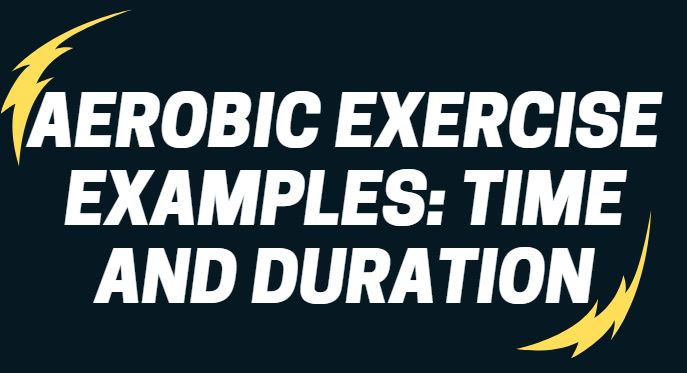
Time refers to the amount of time you exercise during one session. In this case, it is related to your ability to exercise at a given rate for so much time, not that you do not have much time to exercise today because you have many errands to run.
For example, a man wanted to get in shape and lose weight quickly. He started out after he warmed-up, jogging for 5 minutes, picked up the pace just a bit more and then had to stop due to exhaustion after a total of 8 minutes.
He too is just starting an exercise program. It is great that he is trying, but if you add up the energy or calories it took him to perform that amount of work in 8 minutes, it would (in his case) be around 78 calories used.
If he would have had the patience to exercise at a more moderate pace for his fitness level, he would have been ultimately able to do more work. Perhaps walking for 45 minutes would have burned about 225 calories in this case.
We can always use time to classify how hard an exercise is. According the ACSM, aerobic exercise is classified as the following; any movement that you can do using large muscles rhythmically for 5 minutes or longer. Now, that means without having to stop or slow down for 5 minutes or longer.
Lifting a heavy sack or squatting 200 pounds is not done for 5 minutes or longer at once and it generally can’t be performed by the majority of people. Therefore, lifting a heavy sack or squatting 200 pounds is not aerobic, even though they both will increase your heart rate.
During these examples of work, your heart rate readings do not correlate to our bodies O2 usage.
The minimum time we should exercise aerobically is 30 minutes per day, 3 to 5 days per week in order for all the physiological adaptations to take place, according to the ACSM. A gradual progression of up to an hour is fine, with perhaps a 45-minute average to shoot for.
Some people may require 90 minutes or more for competition reasons. If you are sedentary, then you should look to a goal of around 3 ten minute bouts of exercise per day to start with, and then gradually increase your tolerance each time.
Time or exercise duration is harder to pinpoint than intensity when prescribing an exercise program, even for an exercise physiologist. Go along with how good you’re feeling on any given day, while mixing in the occasional isometric exercise session.
Type of Exercise
This refers to what are you going to do for your exercise? Are you going to walk outdoors on this beautiful sunny day, are you going to go for a bike ride with your husband or daughter, or are you going to go to the club and ride an elliptical trainer with your friend?
How do you know what the best exercise is? Well, the TV commercials would have you believe that you can and should choose an exercise that burns more calories. Treadmills do not burn calories, bicycles do not burn calories, and the Abdominizer 8000 does not burn calories. Only YOU can burn calories.
Machines
You can only burn as many calories per time as you are able to do so. This is dependent on your health and fitness level, not on some machine’s ability to “work” you. So with this in mind, pick an exercise that is fun for you and that will be the best.
Biking
If you have concerns such as knee cartilage damage, arthritis, or are significantly overweight, then you may be better off choosing exercises or activities that you are seated and are non-weight bearing. Biking comes to mind. In these cases, to help ease the “wear and tear” on your knees, biking may be better than walking.
Swimming
Swimming is also great. However, if you can only get to a pool once a week or the hassle of doing your hair and make-up is too much of a bother for you then swimming becomes a lesser option in making up your regular exercise program.
Which Aerobic Exercise Should You Choose?

The aerobic exercise you choose should also try to mimic your normal activities of daily living (ADL), work requirements, or sport.
For example, if you work in a factory that you put lots of “widgets” on an assembly line at a fast pace, you may want to incorporate some upper body aerobic work as well, such as a “full body” exercise machine that works your arms and your legs.
Cross County Skiing
Perhaps you love cross-country skiing. In the off-season, you may want to use an indoor skier. If you love to bike during the summer, (I love it myself and recommend it!), then the winter months of exercise should involve regular bouts on a stationary bike, instead of jogging all the time in the winter.
After you exercise, you’re cool!
Cool Down

Cool-down after you exercise. A cool-down is a way to permit blood circulation to steadily stabilize. During exercise, an additional amount of blood gets diverted to the areas that need more blood, the exercising muscles.
These blood flow changes are accomplished with hormones. In this case, they regulate the size of your arteries. Since hormones circulate in the blood, they cannot be just turned off at once.
So a gradual decrease in your exercise intensity or pace is necessary. Blood flow back up to the heart is accomplished, in large part, by the milking action of your veins, which contain one-way valves.
The muscles that run along the sides of veins will squeeze them as they contract and relax. Thus, this acts to push the blood back up to the heart. The possible effects of not performing an adequate cool-down are fainting, or additional stress on your heart as it fights for O2.
As mentioned, a cool-down should be a gradual decrease in your exercise intensity or pace that lasts for about 5 to 10 minutes. Your heart rate may be near 100 bpm or about 20 beats above rest for some. This could also be a way to “measure” if you are cool. It is not related to your body temperature.
Conclusion
Just do it! Please do not look at your current weight, fitness level, or health status and give up hope that you can become much, much healthier with regular exercise. As stated earlier, it is difficult to envision “darting” up a flight of stairs or walking briskly for an hour when you may not be able to walk more than a block right now.
In addition, it is difficult to visualize any extra fat to be off with three days of biking for 30 minutes. But you need to keep up the effort. Have confidence knowing that almost every medical condition can benefit in some way from exercise. You may not know this, but contrary to popular belief, most overweight people have a metabolism that is normal or even above normal. So, no excuses!
No Time for Exercise?
You CAN do it! No time for exercise? The BEST 7.5 Minute Fat Burning Workout You’ll Ever Use. How about considering how important it is to you to lose the extra weight you carry. How about considering how important it is to your spouse and children to have you around a long time and able to lead a life of health and happiness?
Consider all the small ways you can add additional work into your day and the impact that 3,10-minute bouts of exercise can have over the long run on your weight, fitness level, mental well-being, and health.
Best of luck and remember, exercise your right to good health!


